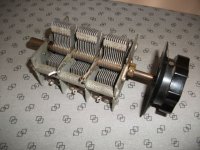Did you try other experiments, with more loops and/or different capacitors?
I'm not Majoco, obviously, but in the late 1980's I made a spiral loop with no formula whatsoever. I saw some pictures of spiral loops, and decided to make one that looked similar.
I made a 3.5 foot one where I wound a ton of old, enamelled wire on a crosspiece made of two 1x2's. I had a small varicap (the cheap plastic kind you could get for a couple bucks at Radio Shack), and soldered the ends of the loop to the varicap. Then I cut it to fit.
At first, it was a Longwave loop -- I had a bit too much wire on it for MW DXing, and it was covering 800 kHz or so down to 400 kHz or lower. Cutting down a few loops brought it into MW territory, covering 520-1600+ or so.
I logged stations in South Korea, Russia, a station in Colombia, a couple stations fairly deep in Mexico, and stations all over the Western US with the loop, DXing with that loop and a boombox.
The point being that when you're making MW DX loops, formulas really aren't as important as winding the loop, cutting to fit.



